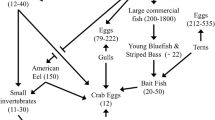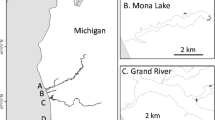Abstract
Plants, aquatic insects, and mosquitofish (Gambusia affinis) were collected from Kesterson Reservoir, Merced County, California, and a nearby reference site (Volta Wildlife Area) to compare concentrations of three contaminants found in 1985 with those reported in 1983 and 1984. Mean selenium concentrations in food-chain organisms from sites at Kesterson in 1985 ranged from 26.0 μg/g (dry wt) in water boatman (Corixidae) to 119 μg/g in mosquitofish. All mean selenium concentrations at Kesterson were significantly higher than those from Volta and were sufficient to have caused the impaired avian reproduction observed at Kesterson. Boron concentrations were also significantly higher at Kesterson, and, at one pond, the mean concentration in widgeongrass (Ruppia mari-tima) (1,630 μg/g) was high enough to impair avian reproduction. There were no differences in arsenic concentrations between locations, and concentrations in all food-chain organisms (<1.9 μg/g) were lower than those reported to cause adverse effects in wildlife. Within-location differences were observed for all three contaminants at Kesterson and for selenium at Volta, but there was no consistent pattern to these differences. Between-year comparisons showed that selenium concentrations in mosquitofish generally decreased at Kesterson, but remained about the same at Volta over the 3 years. Selenium concentrations in insects from 1985 were lower at Kesterson than 1983, but were similar to 1984. Concentrations in plants were generally higher in 1983 and lower in 1984 compared with 1985. Boron concentrations in plants were generally higher in 1985, but in mosquitofish and insects, boron concentrations remained about the same all 3 years. Most arsenic concentrations did not change significantly between years.
Similar content being viewed by others
References
Adrian WJ, Stevens ML (1979) Wet versus dry weights for heavy metal toxicity determinations in duck liver. J Wildl Dis 15:125–126
Arnold RL, Olson OE, Carlson CW (1973) Dietary selenium and arsenic additions and their effects on tissue and egg selenium. Poult Sci 52:847–854
Boumans PWJM, deBoer FJ (1972) Studies of flame and plasma torch emission for simultaneous multi-element analysis-I. Preliminary investigation, Spectrochim Acta 27B:391–414
— (1975) Studies of an inductively coupled high frequency plasma for optical emission spectrometry-II. Compromise conditions for simultaneous multi-element analysis. Spectrochim Acta 30B:309–334
Cherry DS, Guthrie RK, Rodgers JH Jr, Cairns J Jr, Dickson KL (1976) Responses of mosquitofish (Gambusia affinis) to ash effluent and thermal stress. Trans Am Fish Soc 105:686–694
Connelly DP, Chesemore DL (1980) Food habits of pintails,Anas acuta, wintering on seasonally flooded wetlands in the northern San Joaquin Valley, California. Calif Fish Game 66:233–237
Cumbie PM, Van Horn SL (1978) Selenium accumulation associated with fish mortality and reproductive failure. Proc Annu Conf Southeast Assoc Fish Wildl Agencies 32:612–624
Eisler R (1985) Selenium hazards to fish, wildlife, and invertebrates: A synoptic review. US Fish Wildl Serv Biol Rep 85(1.5), Washington, DC, 57 pp
-(1988) Arsenic hazards to fish, wildlife, and invertebrates: A synoptic review. US Fish Wildl Serv Biol Rep 85(1.12), Washington, DC, 92 pp
Greenfield S, Jones IL, McGeachin HM, Smith PB (1975) Automatic multi-sample simultaneous multi-element analysis with a H.F. plasma. Anal Chim Acta 74:225–245
Heinz GH, Hoffman DJ, Krynitsky AJ, Weller DMG (1987) Reproduction in mallards fed selenium. Environ Toxicol Chem 6:423–433
Hoffman DJ, Ohlendorf HM, Aldrich TW (1988) Selenium teratogenesis in natural populations of aquatic birds in Central California. Arch Environ Contam Toxicol 17:519–525
Holland EA (1980) Arsenic and selenium in the water, sediment, and biota near a coal-fired power plant, Belews Lake, North Carolina. Water Pollut Control Fed, 53rd Annual Conf, Las Vegas, NV, 72 pp
Kay SH (1984) Potential for biomagnification of contaminants within marine and freshwater food webs. Tech Rep D-84-7, US Army Corps of Engineers, US Army Engineer Waterways Experimental Station, Vicksburg, MS, 166 pp
Lemly AD (1985) Toxicology of selenium in a freshwater reservoir: Implications for environmental hazard evaluation and safety. Ecotoxicol Environ Safety 10:314–338
Lowe TP, May TW, Brumbaugh WG, Kane DA (1985) National contaminant biomonitoring program: Concentrations of seven elements in freshwater fish, 1978–1981. Arch Environ Contam Toxicol 14:363–388
Neter J, Wasserman W (1974) Applied linear statistical models. Richard D. Irwin, Inc, Homewood, IL
Ohlendorf HM (in press) Bioaccumulation and effects of selenium in wildlife. In: Jacobs LWet al. (eds) Selenium in agriculture and the environment. Special Publ, Amer Soc Agronomy, Madison, WI
Ohlendorf HM, Hoffman DJ, Saiki MK, Aldrich TW (1986a) Embryonic mortality and abnormalities of aquatic birds: Apparent impacts of selenium from irrigation drainwater. Sci Total Environ 52:49–63
Ohlendorf HM, Hothem RL, Bunck CM, Aldrich TW, Moore JF (1986b) Relationships between selenium concentrations and avian reproduction. Trans N Am Wildl Nat Resour Conf 51:330–342
Ohlendorf HM, Hothem RL, Aldrich TW, Krynitsky AJ (1987) Selenium contamination of the Grasslands, a major California waterfowl area. Sci Total Environ 66:169–183
Ohlendorf HM, Kilness AW, Simmons JL, Stroud RK, Hoffman DJ, Moore JF (1988) Selenium toxicosis in wild aquatic birds. J Toxicol Environ Health 24:67–92
Ort JF, Latshaw JD (1978) The toxic level of sodium selenite in the diet of laying chickens. J Nutr 108:1114–1120
Perkin-Elmer (1979) Analytical methods for atomic absorption using the MHS mercury hydride system. Perkin-Elmer, Norwalk, CT
Poley WE, Moxon AL (1938) Tolerance levels of seleniferous grains in laying rations. Poult Sci 17:72–76
Presser TS, Barnes I (1984) Selenium concentrations in waters tributary to and in the vicinity of the Kesterson National Wildlife Refuge, Fresno and Merced counties, California. Water Resour Invest Rep No 84-4122, US Geol Survey, Menlo Park, CA, 26 pp
Presser TS, Ohlendorf HM (1987) Biogeochemical cycling of selenium in the San Joaquin Valley of California, USA. Environ Manage 11:805–821
Saiki MK (1987) Relation of length and sex to selenium concentrations in mosquitofish. Environ Pollut 47:171–186
-(in press) Effects of selenium in agricultural drainage on the aquatic environment: U.S. Fish and Wildlife Service research in 1985. Symposium on Selenium and Agricultural Drainage: Implications for the Environment (Selenium III), Berkeley, CA
Saiki MK, Lowe TP (1987) Selenium in aquatic organisms from subsurface agricultural drainage water, San Joaquin Valley, California. Arch Environ Contam Toxicol 16:657–670
Saiki MK, May TW (1988) Trace element residues in bluegills and common carp from the lower San Joaquin River, California, and its tributaries. Sci Total Environ 74:199–217
Schuler CA (1987) Impacts of agricultural drainwater and contaminants on wetlands at Kesterson Reservoir, California. MS Thesis, Oregon State Univ, Corvallis, 136 pp
Smock LA (1979) Analysis of factors influencing whole-body metal concentrations in aquatic insects. PhD Diss, Univ of North Carolina, Chapel Hill, 180 pp
US Environmental Protection Agency (1983) Methods for chemical analysis of water and wastes, method 270.3. EPA-600/4s79-020, Environ Monit Support Lab, Cincinnati, OH
Whetter PA, Ullrey DE (1978) Improved fluorometric method for determining selenium. J Assoc Offic Anal Chem 61:927–930
Wiener JG, Jackson GA, May TW, Cole BP (1984) Longitudinal distribution of trace elements (As, Cd, Cr, Hg, Pb, and Se) in fishes and sediments in the Upper Mississippi River. In: Wiener JG, Anderson RV, McConville DR (eds) Contaminants in the Upper Mississippi River, Butterworth Publ, Stoneham, MA, pp 139–170
Author information
Authors and Affiliations
Rights and permissions
About this article
Cite this article
Hothem, R.L., Ohlendorf, H.M. Contaminants in foods of aquatic birds at Kesterson Reservoir, California, 1985. Arch. Environ. Contam. Toxicol. 18, 773–786 (1989). https://doi.org/10.1007/BF01160291
Received:
Revised:
Issue Date:
DOI: https://doi.org/10.1007/BF01160291




